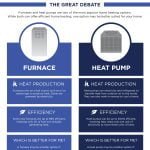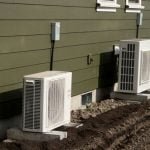When it comes to heating, ventilation, and air conditioning (HVAC) systems, there are two important things to consider: SEER and AFUE. SEER, which stands for Seasonal Energy Efficiency Ratio, measures how well your air conditioner works. On the other hand, AFUE, or Annual Fuel Utilization Efficiency, tells you how efficiently your heating system operates.
Understanding these ratings is crucial for making the right choices for your HVAC system. Why? Well, it’s not just about saving energy; it’s also about saving money. HVAC systems use a lot of energy in homes, so it’s essential to know how efficiently they work. SEER and AFUE ratings are like a guide that helps you choose systems that match your needs and budget.
What is SEER?
What is SEER (Seasonal Energy Efficiency Ratio)
SEER, or Seasonal Energy Efficiency Ratio, is a measurement of the cooling efficiency of an air conditioning system over a typical cooling season. It represents the ratio of cooling output to the energy input. In simpler terms, it indicates how effectively an air conditioner can cool your space.
How the SEER rating is calculated
The SEER rating is calculated by dividing the total cooling output provided by the air conditioner over a cooling season by the total electrical energy input during the same period. The result is a numerical value that represents the efficiency of the system.
SEER = Total Cooling Output / Total Electrical Energy Input
The significance of SEER for air conditioning systems
SEER is important because it helps consumers understand how efficiently an air conditioner can cool their space. A higher SEER rating indicates better efficiency, which can lead to lower energy bills and reduced environmental impact.
Practical examples of SEER ratings in common appliances
For example, a standard window air conditioner may have a SEER rating of 10, while a more energy-efficient central air conditioning system can have a SEER rating of 16 or higher. This means the central system is more efficient in providing cooling.
What is AFUE?
What is AFUE (Annual Fuel Utilization Efficiency)
AFUE, or Annual Fuel Utilization Efficiency, is a measure of the efficiency of a heating system, such as a furnace or boiler. It tells you how effectively the system converts the energy in the fuel it uses into heat for your home.
How AFUE rating is calculated
The AFUE rating is calculated by dividing the heat output during a heating season by the total energy input from the fuel source. The result is expressed as a percentage, indicating the efficiency of the heating system.
AFUE = (Heat Output / Total Energy Input from Fuel Source) x 100
The importance of AFUE for heating systems
AFUE is crucial because it helps homeowners assess how efficiently their heating system uses fuel. A higher AFUE rating means that more of the fuel is converted into heat, leading to cost savings and reduced energy waste.
Practical examples of AFUE ratings in different heating systems
A typical older furnace may have an AFUE rating of 70%, while modern high-efficiency models can achieve AFUE ratings of 90% or more. This means that the newer systems provide more heat with less fuel consumption, making them more cost-effective.
Also Read: SEER vs HSPF: Heat Pumps Efficiency Ratings
Efficiency Showdown: SEER vs AFUE in HVAC Systems
| Key Differences Between SEER vs AFUE |
|---|
| Cooling vs Heating Efficiency |
| SEER focuses on cooling efficiency, while AFUE is about heating efficiency. |
| The Rating Scale |
| SEER ratings are numerical, with higher values indicating better cooling efficiency. AFUE ratings are expressed as percentages, with higher percentages signifying better heating efficiency. |
| Impact on Energy Consumption |
| A higher SEER rating in an air conditioner can lead to lower electricity bills during hot months, while a higher AFUE rating in a heating system can reduce heating costs in the cold season. |
| Cost Implications |
| Investing in a high SEER air conditioner may have a higher upfront cost but can result in long-term savings. Similarly, a heating system with a higher AFUE can be more cost-effective in terms of fuel consumption. |
SEER vs AFUE: Which Rating Matters for You?

The SEER rating measures the cooling efficiency of an HVAC system, indicating how effectively it can convert electricity into cooling power. On the other hand, the AFUE rating reflects the heating efficiency of a system, showing how efficiently it can convert fuel into heat.
Choosing the right rating depends on your specific needs and priorities. If you live in a region with hot summers and mild winters, a high SEER rating may be more important to prioritize efficient cooling. Conversely, in colder climates, a higher AFUE rating may be more beneficial to ensure efficient heating.
Climate Considerations and the Impact on Your Choice
Climate plays a crucial role in determining the appropriate SEER and AFUE ratings for your HVAC system.
Hotter climates require more cooling, making a higher SEER rating desirable to maximize energy efficiency and minimize operating costs.
In colder climates, where heating demands are higher, a higher AFUE rating becomes more important to ensure efficient heating.
Understanding your regional climate and its impact on your heating and cooling needs will help you choose the right rating for your HVAC system.
Balancing SEER and AFUE for a Comprehensive HVAC Solution
While it may be tempting to focus solely on one rating, it’s important to consider both heating and cooling requirements. Look for systems that offer a good balance between SEER and AFUE ratings, ensuring efficient performance throughout the year.
Consulting with HVAC professionals can help you identify systems that meet your specific needs and provide optimal efficiency.
Pros and Cons of High and Low Ratings
Both high and low ratings have their advantages and disadvantages. Systems with high ratings offer greater energy efficiency, resulting in lower operating costs and reduced environmental impact.
However, they often come with higher upfront costs. On the other hand, systems with lower ratings are more affordable initially, but they may lead to higher energy consumption and increased long-term costs.
Evaluating the pros and cons of different ratings will help you determine the most suitable option for your circumstances.
Conclusion
SEER and AFUE are two crucial ratings when choosing HVAC systems. SEER measures cooling efficiency, while AFUE assesses heating efficiency. It’s vital to strike a balance between the two ratings to ensure year-round comfort and energy efficiency.
Making an informed choice regarding these ratings can lead to significant cost savings and a more eco-friendly lifestyle. Energy-efficient HVAC systems not only reduce utility bills but also have a positive impact on the environment.
To compare SEER and AFUE ratings and calculate potential savings, you can use the following tools:





